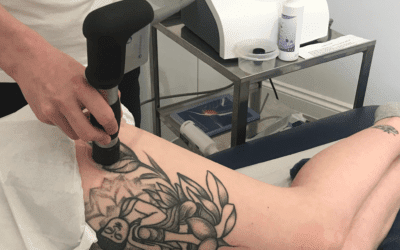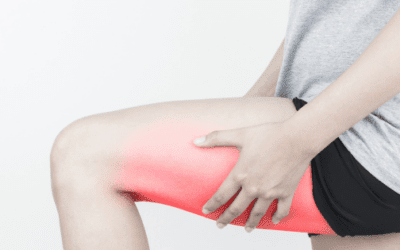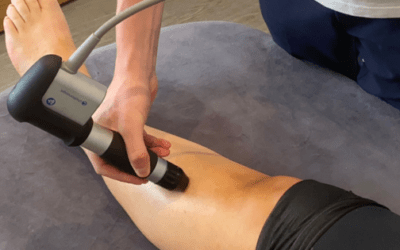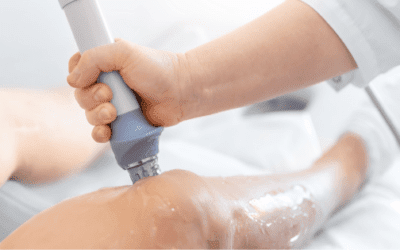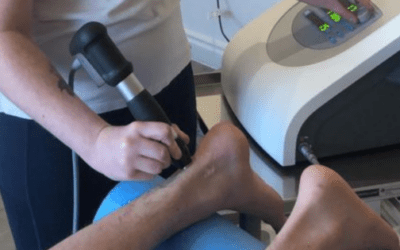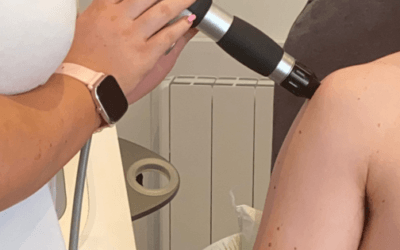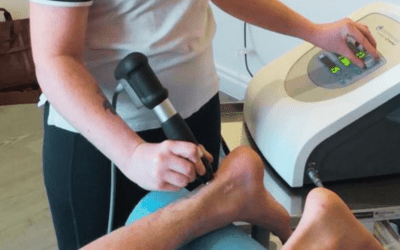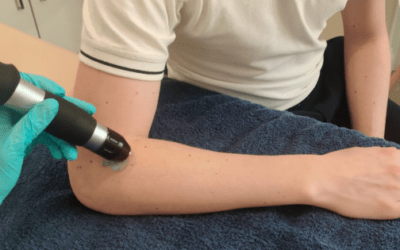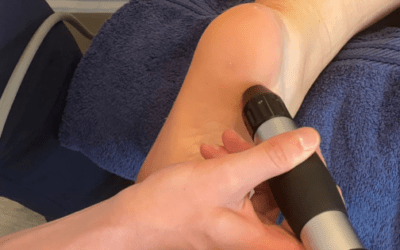Shockwave
Therapy
Prices From
Block Booking x3 Sessions
3 Sessions (Includes Assessment & Treatment + 2 Follow Up Appointments) –
£282
Block Booking x6 Sessions
6 Sessions (Includes Assessment & Treatment + 5 Follow Up Appointments – Saving of £46)
£512
What Is Shockwave Therapy?
This therapeutic device Shockwave therapy is a non-invasive treatment that uses acoustic sound waves to produce a pro-inflammatory and inflammatory response within body tissue.
The device performs vibration like impulses onto the affected area that are generated through air compression within the handheld device. This action causes increased blood flow to the area as well as stimulating tissue at a cellular level leading to improved tissue regeneration.
This helps to kickstart a stalled healing process whilst producing an analgesic effect leading to reduced pain which can last up to four weeks post treatment.
What Can Be Treated With Shockwave Therapy?
This form of treatment will be recommended to patients presenting with a number of conditions such as:
- Achilles tendon pain
- Plantar fasciitis (pain under the foot or heel)
- Patellar tendinopathy (pain under the knee bone)
- Iliotibial band syndrome (pain along the side of your leg from hip to knee)
- Medial tibial stress syndrome (shin splints)
- Proximal hamstring tendinopathy
- Gluteal tendinopathy
- Shoulder pain, rotator cuff tendinopathy, impingement or frozen shoulder
- Lateral epicondylitis (tennis elbow)
- Medial epicondylitis (golfers elbow)
Treatment options will be discussed within initial assessment based on specific tests for the area of pain or irritation.
Contraindications For Treatment
One of the most positive aspects of shockwave therapy is that because this is a non-invasive form of treatment there are only a small number of reasons preventing the use of this therapy. The international society for medical shockwave treatment indicates the following contraindications for radial shockwave:
- Malignant tumour in the treatment area
- Pregnancy (only when treating the area surrounding the fetus)
Precautions for treatment will be reviewed before treatment, these will only prevent use of shockwave if the area corresponds to the injury site:
- Infection within the surrounding area
- Blood clotting
- Electronic implants
- Local infection
- Metal implants
- Recent radiotherapy
- Severely impaired circulation
How It Works?
A probe is pressed on to the affected area and the shockwaves are delivered through the skin. The impulses are delivered through the skin as a shockwave that spreads inside the injured tissue as a radial sound wave. These radial shockwaves initiate an inflammation-like response in the injured tissue that is being treated, and prompts the body to respond naturally by increasing blood circulation which helps to restart the healing process.
The device will produce fast repetitive pulses over the effected area, which will feel like vigorous tapping. Typically, your first treatment will start with a low level of intensity and increase to a point where you feel comfortable. The aim is to stimulate the area, meaning a minor level of discomfort may be felt when receiving treatment, however this will be monitored by the therapist throughout application.
Evidence within research suggests that a minimum of three sessions must be completed in order to provide effective stimulation to the effected area with the optimum of six sessions. It is recommended that duration between treatment should not exceed 10 days to ensure the treatment effect is not lost between sessions.
Who it Can Help?
This treatment is great for patients with both chronic and acute issues that are not progressing as quickly to hands on techniques.
Research suggests that problems relating to tendons and muscles can be effectively treated via shockwave therapy. Due to the analgesic affect this is an effective treatment for people struggling with long term pain. Through restarting the healing process patients can become more mobile without the restriction of pain. This ensures that accompanying treatments such as mobilisation and strengthening exercises can be completed without triggering high levels of pain.
Why Shockwave May Be Right For You
When there is irritation to muscle or tendon tissue fibres. Typically, the body will initiate a natural healing process within the affected area and start to rebuild the fibres. However, in some cases this healing process is halted, often due to insufficient rest and appropriate stimulation of the injured area. In these cases, the issue may not heal back to normal and remain irritated and painful. This is where shockwave is very effective, this treatment helps to stimulate the effected area and restart the healing process by triggering an inflammatory response within tissue.
Main Research Findings
Evidence suggests that Radial shockwave therapy is effective when treating lower limb conditions such as Achilles tendinopathy, plantar fasciitis, greater trochanteric pain syndrome and medial tibial stress syndrome within all phases of rehabilitation. (Korakakis, 2018)
Radial shockwave was found to be superior to ultrasound therapy when treating upper limb tendon injuries where pain levels were considerably lower after ultrasound therapy. (Kubot, 2017).
Likelihood of overall improvement has been reported for many common conditions, percentage likelihood across all conditions range from 60% to 80% improvement from pre to post treatment. (NICE Guidelines).
What To Expect During Shockwave Treatment
Shockwave therapy is administered through a handheld device operated by your therapist, it is important to arrive for your appointment appropriately dressed as the device must be placed directly onto skin (i.e shorts or vest top depending on the area to be treated). The intensity and duration of treatment will be explained before treatment begins. It is normal to feel some mild discomfort during treatment. Your therapist will monitor your symptoms throughout your treatment. As the treatment goes on, your tolerance increases due to the pain dampening effects allowing your therapist to increase the intensity which in turn increases the positive treatment effects.
At Physio-logical we will perform two types of treatment approaches during the session, we first aim at targeting the effected tendon, performing a cross friction technique to stimulate the fibres within the tendon. We also treat the associated musculature using massage like motions to release trigger points within the muscle. These two approaches help to ensure the entire effected areas are treated together which maximises positive treatment effects.
Evidence within research suggests that a minimum of three sessions must be completed in order to provide effective stimulation to the affected area with the optimum of six sessions. It is recommended that duration between treatment should be 5- 10 days to ensure the treatment effect is not lost between sessions.
What To Expect After Shockwave Treatment
Treatment effects vary based on the individual and also the area treated. Common reports following treatment are a dampening of pain within the area which will allow improvement in range of movement. We encourage people receiving this treatment to refrain from moderate and vigorous physical activity for two days post treatment, as this may lead to overloading the effected area whilst it is healing.
There is medical evidence to support the treatments inclusion in the NICE guidelines. Improvements which have been reported;
77% for Tennis Elbow
90% improvement in Plantar Fascia symptoms
75% for Achilles and Patellar Tendinopathy
91% improvement for Calcific Tendinitis
This treatment is great for patients who have a niggling pain in a tendon or muscle which is not improving with hands on techniques.
Read Our Shockwave Blog
Treating Golfers Elbow with Shockwave Therapy
What is Golfers Elbow? Golfer’s elbow, known as medial epicondylitis is an inflammatory condition of the inner side of the elbow, where the tendons of your forearm muscles attach to the bony bump on the inside of your elbow. It’s not unusual for elbow pain to radiate...
Shockwave Therapy for Gluteal tendinopathy
What is Gluteal tendinopathy? Glute tendinopathy is a painful injury; it can be acute or chronic. The condition is characterised by pain on the lateral/outside hip caused by reoccurring or prolonged compressive forces. Tendons are designed to accept and disperse load,...
Treating Proximal Hamstring Tendinopathy with Shockwave Therapy
What is a proximal Hamstring tendinopathy? Proximal hamstring tendinopathy is a condition seen in patients of all ages from the young long-distance runners and sprinters to the more sedentary elderly person. It is also known as high hamstring or hamstring origin...
Shockwave Therapy For Shin Splints (MTSS)
What is Medial Tibial Stress Syndrome? Medial tibial stress syndrome or MTSS is often referred to as shin splints. It is an overuse injury which leads to persistent dull pain at the front of the shin along the edge of the tibia. It is more common in those who don’t...
Shockwave Therapy For Patella Tendinopathy
What is Patella Tendinopathy? Patellar tendinopathy is a condition that can happen when the tendon that joins your kneecap (patella) to your shin bone (tibia) becomes irritated. Your tendon becomes weaker and painful, and is less able to cope with loading, therefore...
Shockwave for Iliotibial band (ITB) knee pain
What is Iliotibial Band (ITB)? The Iliotibial band (ITB) is an important thick strap of connective tissue which runs down the lateral (outside) thigh connecting the hip muscles to the lower knee and shin bone, helping to stabilise the knee joint. The ITB can become...
Shockwave Therapy For Achilles Tendinopathy
What is Achilles Tendinopathy? The Achilles tendon is the largest and strongest tendon in the human body, it attaches your calf muscles to the heel bone. Achilles’ tendinopathy is a common overuse injury caused by excessive compression of the tendon resulting from...
Shockwave for Rotator Cuff Shoulder Pain
Rotator cuff tendinopathy is a painful injury, it can be acute or chronic. The condition is characterised by pain, often along the side and front of shoulder, weakness when lifting and rotating the arm, and can sometimes be accompanied by clicking and a catching pain...
Shockwave treatment for Chronic Achilles Tendinopathy
Case Study - Shockwave treatment for Chronic Achilles Tendinopathy Symptoms A 72 year old client came into the clinic presenting with sharp pain in the right Achilles, which gradually started 3 weeks prior whilst walking their dog. The following morning the...
Treating Tennis Elbow with Shockwave Therapy
Shockwave therapy has a success rate of 77% for tennis elbow pain.What Is Tennis Elbow? Tennis elbow (lateral epicondylitis) is an overuse and muscle strain injury. The cause is repeated contraction of the forearm muscles that you use to straighten and raise your hand...
Treating Plantar Fasciitis with Radial Shockwave Therapy
What is Plantar Fasciitis? Plantar fasciitis is a painful condition of the foot caused by repetitive strain to the plantar fascia. This is a fibrous band of soft tissue connecting your heel bone to your toes. It’s main function is to support the arch of your foot,...
Shockwave Therapy Prices
£98
First Appointment Including Assessment
£92
Follow Up Appointment (up to 30 minutes)
£282
3 Sessions (Includes Assessment & Treatment + 2 Follow Up Appointments)
£512
6 Sessions (Includes Assessment & Treatment + 5 Follow Up Appointments – Saving of £46)
£100
How do I book an appointment?
To book your first appointment with us:
Book Online
You can book online here
Call Us
Give us a call on 07835712306 / 02394-350270. Our phone lines are open from 8am-5pm weekdays.
Email Us
Email us at enquiries@physio-logical.net.
We will be able to find a convenient time for you to come in and see us at our clinic in Stansted Park, Rowlands Castle. Our clinic is located close to Hayling Island, Emsworth, Waterlooville, Havant, and Chichester.
We want you to keep taking part in the sports and activities you love doing.


